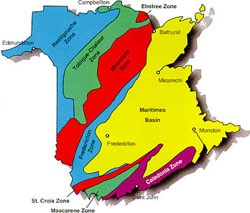
The Appalachian Orogen of New Brunswick is divided into northeast-trending tectonostratigraphic zones recognized on the basis of their unique stratigraphy and deformational history.
The Caledonia Zone is underlain by a Middle Proterozoic quartzite-carbonate sequence and a succession of Late Proterozoic volcanic and associated intrusive rocks. A Cambrian to Early Ordovician platformal sequence containing a distinctive Acado-Baltic trilobite fauna unconformably overlies Precambrian rocks. The Caledonia Zone is generally considered to represent a crustal fragment rifted from the margin of Gondwana during opening of the Early Paleozoic Iapetus Ocean.
The St. Croix, Miramichi, and Elmtree zones contain volcanic assemblages with supra-subduction-zone chemical signatures. The St. Croix Zone is characterized by Late Cambrian to Early Ordovician volcanic rocks and Early to Middle Ordovician shales and wackes. The Miramichi Zone comprises Early to Middle Ordovician volcanic rocks built upon a thick substratum of Cambrian turbidites. The Elmtree Zone is underlain by a Middle Ordovician ophiolitic suite. The arc and back-arc terranes represented by the St. Croix, Miramichi, and Elmtree zones were accreted to the Gondwanan continental margin during contraction of the Iapetus Ocean in the Late Ordovician to Silurian.
The Fredericton and Restigouche zones contain thick successions of calcareous and siliciclastic turbidites ranging from Late Ordovician to Early Devonian. These deep-marine sedimentary sequences were likely deposited in foredeep basins developed in front of rising nappes during closure of the Iapetus Ocean and the subsequent collision of the Gondwanan (combined Africa and South America) and Laurentian (North America) continental margins.
The Mascarene and Tobique–Chaleur zones are underlain by Silurian to Early Devonian volcanic rocks interbedded with shallow-marine to fluviatile sedimentary rocks. The volcanic rocks possess intraplate chemical signatures and were probably erupted in transcurrent basins formed as a result of oblique continental convergence. Thickening of continental crust generated bimodal batholithic suites that were emplaced between the Late Silurian and Middle Devonian.
The Maritimes Basin includes Late Devonian to Carboniferous fluviatile conglomerate and sandstone sequences, shallow-marine limestone and evaporites, lacustrine oil shales, and subaerial volcanic rocks. These rocks were deposited in a successor basin within the uplifted Appalachian Orogen and are undeformed except along fault zones in southern New Brunswick.
